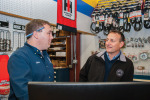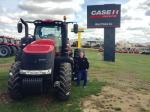A Farm Equipment Staff Report
One could argue that nearly every dealer in North America will be on one side or the other of an acquisition in the years ahead. This report focuses on the first 100 days of integrating a new store into another dealership group following an acquisition, and what it take to successfully meld one organization’s culture into another with a minimum or no loss of performance.
Considering the rate of dealer consolidation in recent years, Farm Equipment editors chose this timely topic as the subject of this year’s special report in the Annual SHOWCASE issue. According to the 2016 Big Dealer report issued by sister publication Ag Equipment Intelligence, there are nearly 200 dealerships that own and operate 5 or more store locations in the U.S. and Canada. There are 26 dealership groups that own 15 or more locations. In total, this group of mega dealers operates more than 800 total locations and nearly 600 stores that primarily handle farm equipment. No one doubts that more consolidation is on the way.
While professional resources exist for dealers willing to pick up the phone and pay for it, many dealers have found that there are few quantifiable answers when dealing with the soft side — or the people part — of an acquisition.
Integrating an acquired store is very much an art; not a science.
This report features the experience of dozens of dealers who have been through or closely observed the consolidation process, as well as other industry experts who have worked closely with dealers before and after an acquisition. Some of the mainline equipment manufacturers also contributed to the discussion that follows.
Special Report Table of Contents

Consultants Offer ‘Post-Deal’ Insights
Professional management advisors share top tips on how to integrate store cultures, operations and systems on ‘Day 1’ of an acquisition.
Appoint an Integration Manager
Consultant Michael O’Connor stresses that an acquisition should have an “integration manager” to run point on a process that could take 3 months to a year.
6-Point Plan for First 100 Days
Farm Equipment asked consultant Floyd Jerkins what specific advice he’d give a dealer on what to do in his first 100 days after inking a deal. To Jerkins, it’s about stabilization, integrating controls and processes, and addressing financial shortcomings.
Assimilating an Acquired Dealership: Issues & Missteps
Buying another dealership is the easy part. Integrating it into the overall organization is the bigger challenge.

One Dealership’s ‘Acquisition Journal’
New manager Davin Peterson recalls the first few months following an acquisition — in which he was getting to know both parties.

Cultural Integration:
Embrace Change From the Get Go
Agriterra Equipment is an ever-growing dealership group that stresses open communication in the days following an acquisition.

Plan Early, But Have Patience
While Champlain Valley Equipment doesn’t have a script for acquiring another dealership, planning early and addressing challenges as they appear has led to six smooth dealership transitions for the company.
A History of Acquisitions and Owner
Transitions for Champlain Valley Equipment
Over the past 15 years, Champlain Valley Equipment, a 5-store New Holland, Case IH and Kubota dealership in Vermont, has acquired six other dealerships. In several cases, the selling owner was offered a new position within the dealership. Brian Carpenter, general manager of Champlain Valley, says making the transition from owner to staff member has gone smoothly in each case.
Dealer Takeaways
Because dealers have had a wide variety of experiences when it comes to handling matters following the acquisition of another dealership, there was little if any clear-cut consensus on one “best” approach to some of the biggest and most critical issues involved.

Focusing on People &
Performance Creates a Collaborative Culture
After more than a decade of rapid expansion, North Dakota-based Plains Ag has developed a successful — but still evolving — post-acquisition game plan rooted in honesty, tradition and productivity.
Every Acquisition is a ‘Big’ Deal
Dealers may want to downplay the significance of buying another dealership, but each acquisition is meaningful for the customers and employees who are involved.
Management Talent Required to Meld Business Cultures
One of the reasons some farm equipment dealers have avoided expanding their business operations to other locations is the lack of management talent to effectively oversee the integration of the two business cultures.
Integrating a New Store: What Makes for a Successful Transition?
It’s been said that we learn far more from our failures than we do from our successes. This may be true, but dealers developing an integration plan for what will happen once an acquisition is complete can learn much from what other dealers have done right previously.
Getting a Do-Over: What Dealers
Would Do Differently After an Acquisition
Many dealers who have managed to successfully integrate an acquired dealership into their businesses have found some facet of process they would like to do over, given the opportunity. Here are some of do-overs shared in the Farm Equipment survey on strategies to integrate one dealership culture into another after an acquisition
Starting from Scratch vs. Acquisition
Responding to Farm Equipment’s survey on post-acquisition strategies, Lance Carlson of Quincy Tractor took the opportunity to compare starting a new farm equipment store location from scratch and acquiring an existing dealership.






